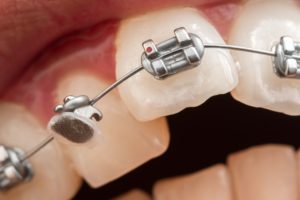
If you have braces, you already know how frustrating it can be to have to work around the metal wires and brackets installed in your smile. It can be a real chore to remove any food that gets stuck between your teeth, for example. Imagine, then, how concerned you might feel if you have an orthodontic dental emergency. Try though you might, you never know when you might find yourself with a cracked bracket or damaged wire. Fortunately, there are a few things you can do to prevent these types of things from happening. Read on to learn about 3 common issues and how you can avoid them!
Problem #1: Broken Brackets
The metal used to straighten your teeth can be quite brittle which is why there’s a long list of restricted foods to keep in mind when you have braces. If you disregard your orthodontist’s instructions regarding your eating habits, you’re likely to end up hurting the materials. If you eat sticky candy, for example, it could loosen or break a bracket. Your braces can’t do their job if they’ve shifted out of place or are too compromised to withstand the pressure of pulling your teeth together. That means that following the orders from your orthodontist in detail is essential to keeping your braces whole.
Problem #2: Snapped Wires
In addition to harming the brackets, ignoring dietary restrictions can also hurt the metal wires in your mouth. Your braces depend on these to reposition your pearly whites. When one is divided, the carefully curated force pulling your teeth to their rightful places is interrupted. Your smile could be pulled further out of alignment if you don’t have your orthodontist address the issue sooner rather than later. Plus, the change in the pressure can cause aching teeth and gums. Call your orthodontist so they can replace the wire and ensure that everything is adjusted accordingly.
Problem #3: Soft Tissue Cuts
Whether it’s the wires or the brackets, having broken metal in your mouth is a health risk. The now sharp edges are notorious for poking patients inside their lips and cheeks which can cause quite a bit of irritation. They can even form wounds or blisters due to repeatedly rubbing against the tender flesh inside your mouth when you speak or eat. This can be as uncomfortable as it is dangerous because oral infections can enter your bloodstream and travel to the rest of your body. Some have been known to contribute to more serious health conditions like heart disease and diabetes.
You can smooth the sharp edges by placing a small amount of wax over the sharp corners so they’re less obtrusive until you can see your orthodontist for repairs.
The number one cause behind most orthodontic emergencies is eating foods that are known to damage your braces. By carefully following the provided instructions and dietary restrictions, you can keep your treatment on track!
About the Author
Dr. Justyna Balicka has experience straightening smiles for patients of all ages and at different stages of dental development. She originally graduated from Stony Brook University with a bachelor’s in biology and then pursued her doctorate at the New York University College of Dentistry. Now, she’s a Diplomate of the American Board of Orthodontics which involves completing multiple written and clinical examinations. She offers same-day emergency visits, so you don’t have to wait for relief if your braces have broken or you’ve sustained an injury. If you’re in an urgent situation, you’re welcome to request an appointment on the website or by calling (631) 423-7857.

